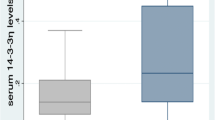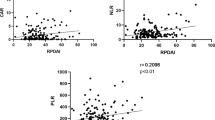Abstract
Objectives
We aimed to identify a serum biomarker for evaluating the disease activity of relapsing polychondritis (RP).
Methods
We measured and compared serum levels of 28 biomarkers potentially associated with this disease, including soluble triggering receptor expressed on myeloid cells-1 (sTREM-1), high-sensitivity C-reactive protein (hs-CRP), and cartilage oligomeric matrix protein (COMP), in 15 RP patients and 16 healthy donors (HDs). We divided the 15 RP patients into active RP (n = 8) and inactive RP (n = 7) groups, depending on the extent of the disease, and compared candidate markers between groups. The localization of membrane-bound TREM-1 in the affected tissue was examined by immunohistochemistry.
Results
Serum levels of sTREM-1, interferon-γ, chemokine (C–C motif) ligand 4, vascular endothelial growth factor, and matrix metalloproteinases-3 were significantly higher in RP patients than HDs. Among these markers, sTREM-1 had the highest sensitivity and specificity (86.7 and 86.7 %, respectively). Furthermore, the serum level of sTREM-1 was significantly higher in active RP patients than inactive RP patients (p = 0.0403), but this was not true for hs-CRP or COMP. TREM-1 was expressed on endothelial cells in RP lesions.
Conclusions
The serum level of sTREM-1 may be a useful marker of disease activity in RP.




Similar content being viewed by others
References
Jaksch-Wartenhorst R. Polychondropathia. Wien Arch Inn Med. 1923;6:100.
Pearson CM, Kline HM, Newcomer VD. Relapsing polychondritis. N Engl J Med. 1960;263:51–8.
Lahmer T, Treiber M, von Werder A, Foerger F, Knopf A, Heemann U, et al. Relapsing polychondritis: an autoimmune disease with many faces. Autoimmun Rev. 2010;9:540–6.
Kemta Lekpa F, Kraus VB, Chevalier X. Biologics in relapsing polychondritis: a literature review. Semin Arthritis Rheum. 2012;41:712–9.
Rapini RP, Warner NB. Relapsing polychondritis. Clin Dermatol. 2006;24:482–5.
Foidart JM, Abe S, Martin GR, Zizic TM, Barnett EV, Lawley TJ, et al. Antibodies to type II collagen in relapsing polychondritis. N Engl J Med. 1978;299:1203–7.
Kempta Lekpa F, Piette JC, Bastuji-Garin S, Kraus VB, Stabler TV, Poole AR, et al. Serum cartilage oligomeric matrix protein (COMP) level is a marker of disease activity in relapsing polychondritis. Clin Exp Rheumatol. 2010;28:553–5.
Michet CJ. Diagnostic evaluation of relapsing polychondritis. http://www.uptodate.com/contents/diagnostic-evaluation-of-relapsing-polychondritis.
Terato K, Shimozuru Y, Katayama K, Takemitsu Y, Yamashita I, Miyatsu M, et al. Specificity of antibodies to type II collagen in rheumatoid arthritis. Arthr Rheum. 1990;33:1493–500.
Kent PD, Michet CJ Jr, Luthra HS. Relapsing polychondritis. Curr Opin Rheumatol. 2004;16:56–61.
Gomez-Pina V, Soares-Schanoski A, Rodriguez-Rojas A, Del Fresno C, Garcia F, Vallejo-Cremades MT, et al. Metalloproteinases shed TREM-1 ectodomain from lipopolysaccharide-stimulated human monocytes. J Immunol. 2007;179:4065–73.
Gibot S, Cravoisy A. Soluble form of the triggering receptor expressed on myeloid cells-1 as a marker of microbial infection. Clin Med Res. 2004;2:181–7.
McAdam LP, O’Hanlan MA, Bluestone R, Pearson CM. Relapsing polychondritis: prospective study of 23 patients and a review of the literature. Medicine (Baltimore). 1976;55:193–215.
Damiani JM, Levine HL. Relapsing polychondritis—report of ten cases. Laryngoscope. 1979;89:929–46.
Bouchon A, Dietrich J, Colonna M. Cutting edge: inflammatory responses can be triggered by TREM-1, a novel receptor expressed on neutrophils and monocytes. J Immunol. 2000;164:4991–5.
Chen LC, Laskin JD, Gordon MK, Laskin DL. Regulation of TREM expression in hepatic macrophages and endothelial cells during acute endotoxemia. Exp Mol Pathol. 2008;84:145–55.
Gibot S, Kolopp-Sarda MN, Bene MC, Cravoisy A, Levy B, Faure GC, et al. Plasma level of a triggering receptor expressed on myeloid cells-1: its diagnostic accuracy in patients with suspected sepsis. Ann Intern Med. 2004;141:9–15.
Gibot S, Cravoisy A, Kolopp-Sarda MN, Bene MC, Faure G, Bollaert PE, et al. Time-course of sTREM (soluble triggering receptor expressed on myeloid cells)-1, procalcitonin, and C-reactive protein plasma concentrations during sepsis. Crit Care Med. 2005;33:792–6.
Routsi C, Giamarellos-Bourboulis EJ, Antonopoulou A, Kollias S, Siasiakou S, Koronaios A, et al. Does soluble triggering receptor expressed on myeloid cells-1 play any role in the pathogenesis of septic shock? Clin Exp Immunol. 2005;142:62–7.
Tzivras M, Koussoulas V, Giamarellos-Bourboulis EJ, Tzivras D, Tsaganos T, Koutoukas P, et al. Role of soluble triggering receptor expressed on myeloid cells in inflammatory bowel disease. World J Gastroenterol. 2006;12:3416–9.
Kuai J, Gregory B, Hill A, Pittman DD, Feldman JL, Brown T, et al. TREM-1 expression is increased in the synovium of rheumatoid arthritis patients and induces the expression of pro-inflammatory cytokines. Rheumatology (Oxford). 2009;48:1352–8.
Daikeler T, Regenass S, Tyndall A, Gencay MM, Roth M, Christ-Crain M, et al. Increased serum levels of soluble triggering receptor expressed on myeloid cells-1 in antineutrophil cytoplasmic antibody-associated vasculitis. Ann Rheum Dis. 2008;67:723–4.
Michet CJ. Vasculitis and relapsing polychondritis. Rheum Dis Clin North Am. 1990;16:441–4.
Zeuner M, Straub RH, Rauh G, Albert ED, Scholmerich J, Lang B. Relapsing polychondritis: clinical and immunogenetic analysis of 62 patients. J Rheumatol. 1997;24:96–101.
Bleharski JR, Kiessler V, Buonsanti C, Sieling PA, Stenger S, Colonna M, et al. A role for triggering receptor expressed on myeloid cells-1 in host defense during the early-induced and adaptive phases of the immune response. J Immunol. 2003;170:3812–8.
Bouchon A, Facchetti F, Weigand MA, Colonna M. TREM-1 amplifies inflammation and is a crucial mediator of septic shock. Nature. 2001;410:1103–7.
Murakami Y, Akahoshi T, Aoki N, Toyomoto M, Miyasaka N, Kohsaka H. Intervention of an inflammation amplifier, triggering receptor expressed on myeloid cells 1, for treatment of autoimmune arthritis. Arthr Rheum. 2009;60:1615–23.
Yamanaka H, Matsuda Y, Tanaka M, Sendo W, Nakajima H, Taniguchi A, et al. Serum matrix metalloproteinase 3 as a predictor of the degree of joint destruction during the six months after measurement, in patients with early rheumatoid arthritis. Arthr Rheum. 2000;43:852–8.
Acknowledgments
We would like to thank Katsunori Takahashi, Yasuo Kunitomo, Yuji Sato, Mikako Koike, and Yumiko Hasegawa for their excellent technical help. This study was supported by a Grant-in-Aid for Scientific Research from the Ministry of Health, Labour and Welfare, Japan.
Conflict of interest
None.
Author information
Authors and Affiliations
Corresponding author
About this article
Cite this article
Sato, T., Yamano, Y., Tomaru, U. et al. Serum level of soluble triggering receptor expressed on myeloid cells-1 as a biomarker of disease activity in relapsing polychondritis. Mod Rheumatol (2013). https://doi.org/10.1007/s10165-013-0833-z
Received:
Accepted:
Published:
DOI: https://doi.org/10.1007/s10165-013-0833-z




